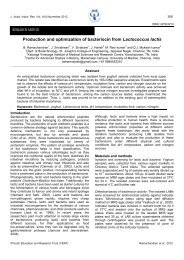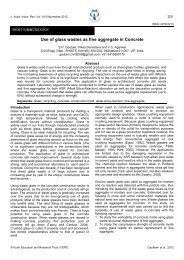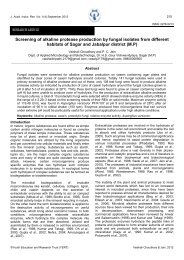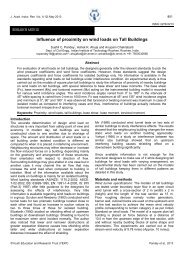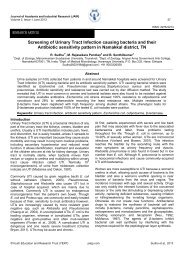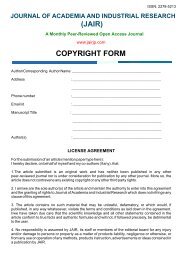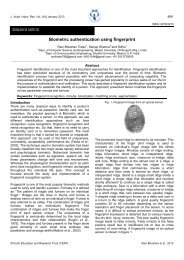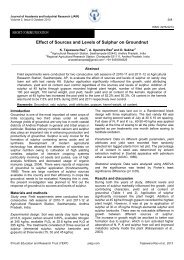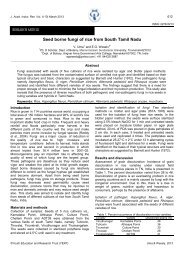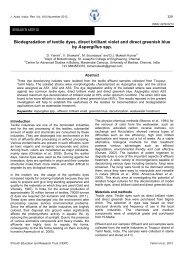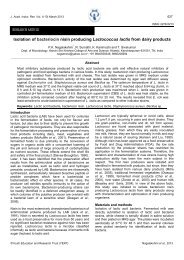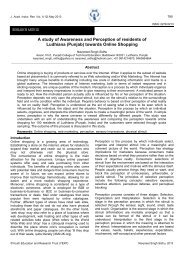Evaluation of Antiproliferative effect of Grewia hirsuta on HepG2 cell ...
Evaluation of Antiproliferative effect of Grewia hirsuta on HepG2 cell ...
Evaluation of Antiproliferative effect of Grewia hirsuta on HepG2 cell ...
You also want an ePaper? Increase the reach of your titles
YUMPU automatically turns print PDFs into web optimized ePapers that Google loves.
Journal <str<strong>on</strong>g>of</str<strong>on</strong>g> Academia and Industrial Research (JAIR)Volume 2, Issue 1 June 2013 2Radical scavenging activity was expressed as theinhibiti<strong>on</strong> percentage <str<strong>on</strong>g>of</str<strong>on</strong>g> free radical by the sample andwas calculated using the formula:% DPPH activity = (C<strong>on</strong>trol OD–Sample OD/C<strong>on</strong>trol OD) × 100.Phosphomolybdenum assay: Antioxidant activity <str<strong>on</strong>g>of</str<strong>on</strong>g>samples was evaluated by green phosphomolybdenumcomplex formati<strong>on</strong> according to Prieto et al. (1999).An aliquot <str<strong>on</strong>g>of</str<strong>on</strong>g> 100 μL <str<strong>on</strong>g>of</str<strong>on</strong>g> sample soluti<strong>on</strong> was combinedwith 1 mL <str<strong>on</strong>g>of</str<strong>on</strong>g> reagent soluti<strong>on</strong> (0.6 M sulphuric acid,28 mM sodium phosphate and 4 mM amm<strong>on</strong>iummolybdate) in a 4 mL vial. The vials were capped andincubated in a water bath at 95C for 90 min. Aftercooling, the absorbance <str<strong>on</strong>g>of</str<strong>on</strong>g> the mixture was measured at695 nm against a blank. Ascorbic acid (10 mg/mLDMSO) was used as standard. The results were reportedas % phosphomolybdenum reducti<strong>on</strong> potential.Hydroxyl radical scavenging activity: The scavengingactivity <str<strong>on</strong>g>of</str<strong>on</strong>g> the methanol extracts <strong>on</strong> hydroxyl radical wasmeasured according to Klein et al. (1992). Variousc<strong>on</strong>centrati<strong>on</strong>s (250, 500, 750 and 1000 μg/mL) <str<strong>on</strong>g>of</str<strong>on</strong>g>extracts were added with 1.0 mL <str<strong>on</strong>g>of</str<strong>on</strong>g> ir<strong>on</strong>‐EDTA soluti<strong>on</strong>,0.5 mL <str<strong>on</strong>g>of</str<strong>on</strong>g> EDTA soluti<strong>on</strong> and 1.0 mL <str<strong>on</strong>g>of</str<strong>on</strong>g> dimethylsulphoxide (DMSO). The reacti<strong>on</strong> was initiated by adding0.5 mL <str<strong>on</strong>g>of</str<strong>on</strong>g> ascorbic acid and incubated at 80-90C for15 min in a water bath. After incubati<strong>on</strong> the reacti<strong>on</strong> wasterminated by the additi<strong>on</strong> <str<strong>on</strong>g>of</str<strong>on</strong>g> 1.0 mL <str<strong>on</strong>g>of</str<strong>on</strong>g> ice‐cold TCA.Nash reagent (3 mL) was added and left at roomtemperature for 15 min. The reacti<strong>on</strong> mixture withoutsample was used as c<strong>on</strong>trol. The intensity <str<strong>on</strong>g>of</str<strong>on</strong>g> the colorformed was measured spectroscopically at 412 nmagainst reagent blank. The % hydroxyl radicalscavenging activity (HRSA) is calculated by the followingformula:% HRSA = [(Abs c<strong>on</strong>trol‐Abs sample)/Abs c<strong>on</strong>trol] × 100Where, Abs c<strong>on</strong>trol is the absorbance <str<strong>on</strong>g>of</str<strong>on</strong>g> the c<strong>on</strong>trol;Abs sample is the absorbance <str<strong>on</strong>g>of</str<strong>on</strong>g> the extract/standard.Metal chelating activity: The chelating <str<strong>on</strong>g>effect</str<strong>on</strong>g> <str<strong>on</strong>g>of</str<strong>on</strong>g> ferrousi<strong>on</strong>s by the extracts was estimated according to Diniset al. (1994). Hundred μL <str<strong>on</strong>g>of</str<strong>on</strong>g> the extract was added to0.05 mL <str<strong>on</strong>g>of</str<strong>on</strong>g> 2 mM FeCl 2 . The reacti<strong>on</strong> was initiated by theadditi<strong>on</strong> <str<strong>on</strong>g>of</str<strong>on</strong>g> 0.2 mL <str<strong>on</strong>g>of</str<strong>on</strong>g> ferrozine (5 mM) and the mixturewas shaken vigorously and left at room temperature for10 min. Absorbance <str<strong>on</strong>g>of</str<strong>on</strong>g> the soluti<strong>on</strong> was then measuredspectrophotometrically at 562 nm. The chelating activity<str<strong>on</strong>g>of</str<strong>on</strong>g> the extracts was evaluated using EDTA as standard.The results were expressed as % metal chelatingactivity. The ratio <str<strong>on</strong>g>of</str<strong>on</strong>g> inhibiti<strong>on</strong> <str<strong>on</strong>g>of</str<strong>on</strong>g> ferrozine Fe 2+ complexwas calculated as follows:% inhibiti<strong>on</strong> = (C<strong>on</strong>trol OD–Sample OD/C<strong>on</strong>trol OD) × 100.Qualitative and quantitative phytochemical screening:The extracts were subjected to preliminaryphytochemical screening to identify the presence <str<strong>on</strong>g>of</str<strong>on</strong>g>phytoc<strong>on</strong>stituents such as alkaloids, flav<strong>on</strong>oids,sap<strong>on</strong>ins, tannins, phenols, glycosides and steroidsaccording to Harborne (1973).Estimati<strong>on</strong> <str<strong>on</strong>g>of</str<strong>on</strong>g> total free phenolics: Total phenolicc<strong>on</strong>stituents <str<strong>on</strong>g>of</str<strong>on</strong>g> plant extracts were estimated byFolin-Ciocalteau’s method using Folin-Ciocalteu reagent.The estimati<strong>on</strong> was d<strong>on</strong>e spectrometrically at 760 nmand the results were expressed as gallic acid equivalents(GAE) (Sengul et al., 2009).Estimati<strong>on</strong> <str<strong>on</strong>g>of</str<strong>on</strong>g> total flav<strong>on</strong>oids: Aluminium chloride methodwas employed to quantify the total flav<strong>on</strong>oid c<strong>on</strong>tent inthe plant extracts. The results were expressed asquercetin equivalents (QE) (Chang et al., 2002).Estimati<strong>on</strong> <str<strong>on</strong>g>of</str<strong>on</strong>g> total alkaloids: Total alkaloid c<strong>on</strong>tent <str<strong>on</strong>g>of</str<strong>on</strong>g> theplant extracts was determined according to Sutharsinghet al. (2011). Five gram <str<strong>on</strong>g>of</str<strong>on</strong>g> the sample was filtered andc<strong>on</strong>centrated to <strong>on</strong>e quarter <str<strong>on</strong>g>of</str<strong>on</strong>g> the original volume <strong>on</strong> awater bath after treatment with 200 mL <str<strong>on</strong>g>of</str<strong>on</strong>g> 10% aceticacid in ethanol. C<strong>on</strong>centrated NH 4 OH was addeddrop wise to the extract until the precipitati<strong>on</strong> wascomplete. The whole soluti<strong>on</strong> was allowed to settle andthe precipitate was collected and washed with diluteNH 4 OH, filtered and weighed.Estimati<strong>on</strong> <str<strong>on</strong>g>of</str<strong>on</strong>g> total sap<strong>on</strong>ins: Powdered sample (20 g)was treated with 100 mL <str<strong>on</strong>g>of</str<strong>on</strong>g> 20% aqueous ethanol,heated over a hot water bath for 4 h at about 55°C withc<strong>on</strong>tinuous stirring. The mixture was filtered and theresidue re-extracted. The combined extracts werereduced to 40 mL over water bath at about 90°C and thec<strong>on</strong>centrate was transferred into a separating funnel and20 mL <str<strong>on</strong>g>of</str<strong>on</strong>g> diethyl ether was added and shaken vigorously.The aqueous layer was recovered while the ether layerwas discarded. The purificati<strong>on</strong> process was repeatedand 60 mL <str<strong>on</strong>g>of</str<strong>on</strong>g> n-butanol was added to the combinedextracts and washed twice with 10 mL <str<strong>on</strong>g>of</str<strong>on</strong>g> 5% aqueousNaCl. The remaining soluti<strong>on</strong> was heated in a waterbath, dried in an oven to a c<strong>on</strong>stant weight and thesap<strong>on</strong>in c<strong>on</strong>tent was calculated as percentage(Sutharsingh et al., 2011).Thin layer chromatography: The plant extract was loaded<strong>on</strong> pre-coated silica plates which were then developedusing methanol, chlor<str<strong>on</strong>g>of</str<strong>on</strong>g>orm in the ratio <str<strong>on</strong>g>of</str<strong>on</strong>g> 1:9. The spotswere identified both in the UV light and in the iodinechamber. Then R f value was calculated as the ratio <str<strong>on</strong>g>of</str<strong>on</strong>g>distance travelled by the solute to the distance travelledby the solvent (El<str<strong>on</strong>g>of</str<strong>on</strong>g>f, 1998).Bioautography: The extract which showed DPPHinhibiti<strong>on</strong> <str<strong>on</strong>g>of</str<strong>on</strong>g> more than 90% was examined by thin layerchromatography (TLC) bioautography.©Youth Educati<strong>on</strong> and Research Trust (YERT) jairjp.com Ashana Ema et al., 2013



